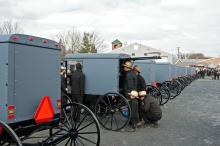porn

At the time, authors like conservative political activists Tim and Beverly LaHaye and Focus on the Family founder James Dobson acknowledged that porn was a problem that Christians (almost always men but on occasion women) faced. Their writing focused on how pornography harmed marital relationships and personal well-being. At the same time, however, it described how devout Christians may be pornography consumers.

Naming it “corrosive” and a “dark” sign of contemporary American culture, the U.S. Catholic bishops approved a document this week condemning the production and use of pornography as a mortal sin.
Reaction from the bishops’ critics didn’t take long. Some said the bishops themselves have very serious problems with pornography; others pointed out the not-so-distant sex abuse crisis. The upshot was that the bishops ought to have different priorities.
One could be forgiven for confusing this disagreement with one from the 1980s. Didn’t it play out over a generation ago — with the result that our culture basically accepts porn as part of sexual liberation?

UNTIL RECENTLY, a company in New York City offered “a ride through a real New York City ‘ghetto’”—a $45 bus tour of the Bronx, reportedly patronized mainly by European and Australian tourists. One news report described the tour guide sharing lurid stories of crime and arson from the ’70s and ’80s, making insensitive comments about everything from local architectural landmarks to people waiting in line at a food pantry, and warning about the “pickpockets” in wait in a certain park. After an outcry from residents and officials, angry that the place they call home would be reduced to out-of-touch stereotypes, the tour company shut down in May.
That someone would even think of fleecing misguided tourists this way hints at the complicated, sometimes contradictory, role that cities play in our culture: In our collective imagination they represent both civilization’s pinnacle (arts, style, technology, intellectualism, innovation, industry, finance) and depravity’s depths (crime, corruption, exploitation, decadence, filth). For much of the 20th century, many people of means fled cities for the pastoral promise of the suburbs, while many a farm girl or boy dreamed of escaping to a city and tasting the bustle and thrill: “Until I saw your city lights, honey I was blind.”
And yet cities are not only symbols, but real and intricate places. Whether booming or busting, they shape and are shaped by the people in them. Both the built structures and the people of a city have stories to tell. But a fleeting tour-bus view with distorted narration can lead us down an alley with no exit.
Here are some different takes on the bright lights of the big city.

ONE SUNDAY EVENING during high school, friends from my Mennonite church and I drove around Lancaster County, Pa., stealing mattresses. Bored by too many evenings of roller skating and Truth or Dare, we, like teenagers everywhere, landed on thievery as the solution to adolescent ennui. Having found out which of our friends were away from home, we showed up at their houses, told their parents about our prank, and swore them to secrecy. Then we clomped up narrow staircases to their sons’ and daughters’ bedrooms and wrestled mattresses back downstairs and onto the bed of a pickup truck. Just before our getaways, we left notes on our friends’ dressers, signed with what we thought was a most clever alias: “The Mennonite Mafia.”
We had no idea that 25 years later, Amish Mafia would be a blockbuster reality show, its first episode attracting 10 times more viewers than there are Amish people. Had you told us then that a bunch of Amish and Mennonite kids growing up a few miles away would someday parlay boredom-induced shenanigans into a hit cable TV series, I don’t know whether we would have been flattered or jealous. Kate Stoltzfus? Rebecca Byler? Lebanon Levi? People with names like these—our “plain-dressing” Amish neighbors and the more conservative Mennonite kids we went to school with—were the butt of our jokes, not the cynosures of popular culture.
Only a few decades after we and our families exited the conspicuous conservatism of plain Anabaptism, mass culture is flocking toward it. From Amish-themed reality TV shows to Christian romance novels with Amish characters and settings, the media have finally landed the lucrative Amish account, although the furniture industry and “Weird Al” Yankovic’s “Amish Paradise” got there first. Americans’ enthrallment with the Amish—and schadenfreude about their sometimes wayward youth—has rarely been more intense.